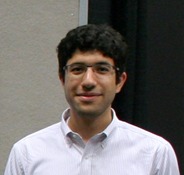Program Information
Exploring Radiation Acoustics CT Dosimeter Design Aspects for Proton Therapy
F Alsanea1*, V Moskvin2 , K Stantz1,2 , (1) Purdue University, West Lafayette, IN, (2) Indiana University- School of Medicine, Indianapolis, IN
Presentations
SU-E-CAMPUS-T-2 Sunday 3:00PM - 6:00PM Room: Exhibit HallPurpose:Investigate the design aspects and imaging dose capabilities of the Radiation Acoustics Computed Tomography (RA CT) dosimeter for Proton induced acoustics, with the objective to characterize a pulsed pencil proton beam. The focus includes scanner geometry, transducer array, and transducer bandwidth on image quality.
Methods:The geometry of the dosimeter is a cylindrical water phantom (length 40cm, radius 15cm) with 71 ultrasound transducers placed along the length and end of the cylinder to achieve a weighted set of projections with spherical sampling. A 3D filtered backprojection algorithm was used to reconstruct the dosimetric images and compared to MC dose distribution. First, 3D Monte Carlo (MC) Dose distributions for proton beam energies (range of 12cm, 16cm, 20cm, and 27cm) were used to simulate the acoustic pressure signal within this scanner for a pulsed proton beam of 1.8x107 protons, with a pulse width of 1 microsecond and a rise time of 0.1 microseconds. Dose comparison within the Bragg peak and distal edge were compared to MC analysis, where the integrated Gaussian was used to locate the 50% dose of the distal edge. To evaluate spatial fidelity, a set of point sources within the scanner field of view (15x15x15cm3) were simulated implementing a low-pass bandwidth response function (0 to 1MHz) equivalent to a multiple frequency transducer array, and the FWHM of the point-spread-function determined.
Results:From the reconstructed images, RACT and MC range values are within 0.5mm, and the average variation of the dose within the Bragg peak are within 2%. The spatial resolution tracked with transducer bandwidth and projection angle sampling, and can be kept at 1.5mm.
Conclusion:This design is ready for fabrication to start acquiring measurements. The 15 cm FOV is an optimum size for imaging dosimetry. Currently, simulations comparing transducer sensitivity, bandwidth, and proton beam parameters are being evaluated to assess signal-to-noise.
Contact Email:


